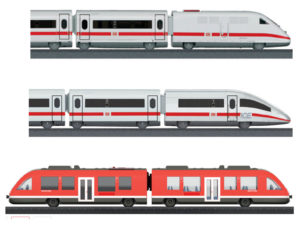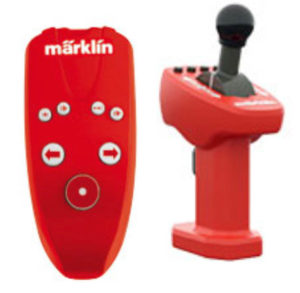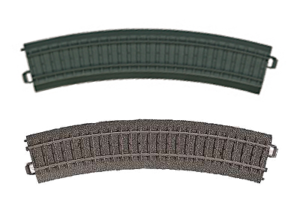Märklin targets their my world program at young children (starting at 3 years of age). Contrary to other modelrailroads, the trains run on batteries or rechargeable batteries. This technology may become available in regular models in the future, but it is already available for the very young. The big advantage is that trains will run on dirty tracks and cannot short-circuit. The trains are strong and will take a beating.
Engines
Most engines run on batteries. They are permanently coupled to the first car or carriage, which holds four AA-batteries. The engines have a red window on top which contains the infrared receiver. They all have lighting, although not directional and 3 sounds. On top also seats an on/off switch. There is also a switch on the bottom, to change between two infrared channels, which must match the channel on the remote control (see below). All engines only have two axles, of which one with rubber tires and have also one magnetic coupler. The fronts of the engines are fairly realistic, e.g. the ICE1 and ICE3, the series 218 and 212. Märklin also sells a LINT multiple unit (red and blue) which can be charged using a USB charger. Some trains are not based on an actual model, e.g. a Dutch high speed train. Also new in 2017 is a steam engine that produces steam using real water.

Remote control
The remote control is available in two shapes. The older one uses pushbuttons, the newer one looks like a kind of joystick (called Power Control Stick). Both also feature 4 pushbuttons for lights on/off and 3 sounds. The older remote control uses buttons foor forwards and backwards and emergency brake. Pushing the speed buttons more than once increases or decreases the speed of the train. The PCS has 7 stops: 3 forwards, 3 backwards and stop. The emergency brake is a button that can be pushed by the hand holding the stick.

The remote control runs on three AAA batteries and uses infrared. This means that the control should be pointed at the red window on a locomotive. Outside the range of the remote control, the train will keep running at the last setting (e.g. through tunnels).
The remote control has a designated set of channels, either A-B, C-D, E-F, G-H, I-J or K-L. Every channel can run an engine independently, so a total of 12 independent trains is possible. The switch on the engine and the remote control should be set to te same channel. Known to us are the following channels:
| Engine /Multiple Unit | Article | Remote control | Channels |
| ICE 1 | 29300 | Pushbuttons | A-B |
| ICE NS | 29213 | Pushbuttons | A-B |
| ICE TV-series with the mouse | 29206 | Pushbuttons | A-B |
| ICE Holiday Express | 466456 | Pushbuttons | A-B |
| ICN SBB | 29303 | Pushbuttons | C-D |
| BR 218 (Regional Express) | 29209 | Pushbuttons | C-D |
| BR 218 (Intercity) | 29302 | Pushbuttons | C-D |
| BR 218 (goods) | 29210 | Pushbuttons | C-D |
| TGV Duplex SNCF | 29212 | Pushbuttons | C-D |
| Click and Mix (2 engines, goods) | 29270 | Pushbuttons | E-F |
| Click and Mix (3 engines) | 36270 | Pushbuttons | E-F |
| LINT | 29100, 29307, 36100 | Power Control Stick | G-H |
| BR 212 (container) | 29309, 36101 | Power Control Stick | G-H |
| Steam engine (agriculture) | 29308 | Power Control Stick | I-J |
| ICE 3 | 29330 | Power Control Stick | K-L |
Cars
When Märklin started out, cars had 4 axles in the so called ’click and mix’ collection. Nowadays all cars, like the engines, have two axles. They are shortened and have a magnetic coupler on both sides. This gives a closed appearance for passenger trains but is less realistic for goods trains. Due to polarity couplers are colored in light and dark gray. Although the cars are shortened considerably, longer trains often look credible enough for older children and adults. Most sets contain 3 or 4 cars, but an engine can easily pull longer trains, even on slopes. The series 212, which will be available in 2017, is the first engine to run on rechargeable batteries, without being permanently coupled to the first car. This set will come with intermodal cars and containers.
Track
My world track is constructed out of one piece of plastic. They are exact copies of regular C-track using the same lengths and curves. Currently the following track sections are available:
- Curve R1, 30 degrees (12 sections make a circle)
- Curve R2, 24 degrees. This is the counterpart for a switch/turnout. (15! pieces make a circle, but no half circle can be made without cutting. They can only be bought in packages also containing switches/turnouts)
- Straight 172 mm
- Straight 188 mm
- Switch/turnout left and right
- 60 degrees crossing (only for a figure 8)

Top a plastic my world track section, bottom regular C-track. Even the third rail is copied (non-functional of course).
Because of the missing 30 degrees curve for R2, double track is only possible in straight sections. Ofcourse a mix can be made with regular C-track, which has a much larger selection (like curved turnouts en R3 and R4). Another advantage is that they will also provide current for regular locomotives. The cost is however almost three times as high.

